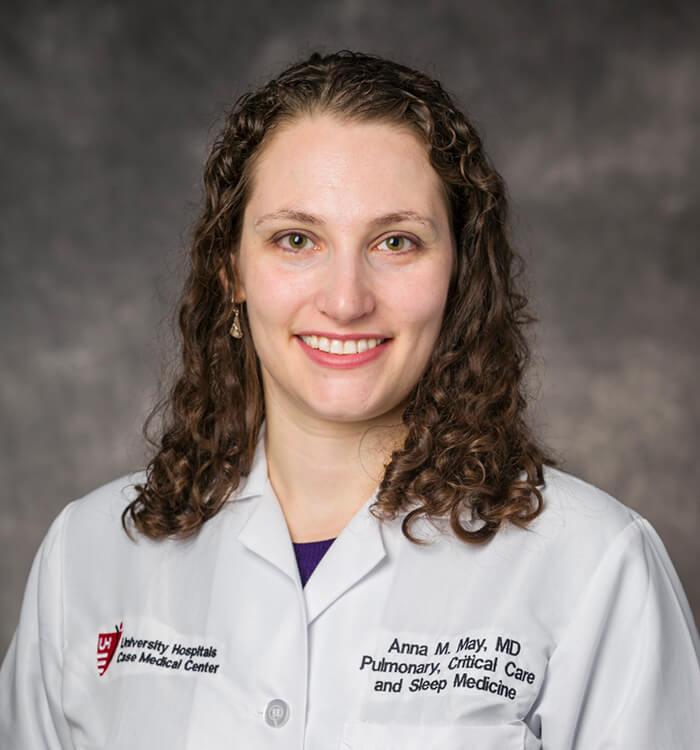Addressing Health Disparities in Treatment for Obstructive Sleep Apnea
June 27, 2023
Inconsistent PAP adherence underlies outcome differences
Innovations in Pulmonology & Sleep Medicine | Summer 2023
Untreated obstructive sleep apnea (OSA) affects patients’ quality of life and increases their risk for cardiovascular events and mental health problems. In the United States, sleep apnea affects an estimated 25 to 30 percent of men, and 9 to 17 percent of women. The prevalence in non-White populations is even higher. PAP, positive airway pressure, is the most effective treatment of adults with sleep apnea. However, after the first month, adherence wanes significantly.
 Anna May, MD, MS
Anna May, MD, MS“PAP is first-line therapy for OSA, and while it’s incredibly effective, it needs to be used to have benefits,” says Anna May, MD, MS, pulmonologist in the Division of Pulmonary, Critical Care, and Sleep Medicine at University Hospitals Cleveland Medical Center. “People who are disadvantaged by race, socioeconomic status or disabilities have lower experience of positive airway pressure. We need to determine how to redefine and improve adherence.”
Current PAP Adherence Guidelines
The U.S. Centers for Medicare and Medicaid Services (CMS) defines adherence and states that within the first 90 days of PAP therapy, patients must have a 30-day period of using the CPAP device for at least four hours for 70 percent of nights. Failure to meet this threshold requires another sleep study to requalify for PAP therapy, which, says Dr May, is not a good use of medical resources.
"We need to learn how to redefine adherence to be more patient-centered and improve adherence. This includes personalized, patient-centered targets based on benefits that account for a multitude of factors, such as individual habitual sleep times, instead of broad one-size-fits-all adherence thresholds, and the recognition that disadvantaged patients have worse sleep quality and don’t sleep as much."
Creating Parity
In an effort to change current guidelines, Dr. May authored a policy statement for the American Thoracic Society, the leading society for Pulmonology, Critical Care and Sleep Medicine. “We have laid out a framework of how to redefine adherence,” she says. “The focus is on patients’ symptoms and goals for therapy, instead of a one-size-fits-all definition of adherence. We advocate clinicians thoroughly discuss expectations for therapy with patients, set goals collaboratively and anticipate potential issues.”
Furthermore, she says, clinicians need to develop programs to encourage adherence in underserved populations.
“Part of the issue is that our medical system is fragmented,” says Dr. May. “Patients have to contract with durable medical equipment (DME) providers to secure CPAP machines and supplies. DME providers are incentivized to prioritize patients most likely to be adherent with minimal effort in order to maximize reimbursements. Monitoring underserved populations may alleviate some of that strain and provide balance.”
The new policy statement is out, and the next step is to partner with other professional medical societies and CPAP and DME companies to advocate for more inclusive PAP adherence policies.
“CMS makes policy, so we want to gather the best experts together to lobby for a better policy,” says Dr. May. She also encourages pulmonologists to notice differences in sleep apnea patients and to offer additional support to traditionally disadvantaged populations or marginalized groups to improve therapy adherence.
“We need a bigger push for additional research for cost-effectiveness of different models in order to enhance the case for CMS to change the current policy,” Dr. May says. “More transparency on CMS’ part would be helpful, as well.”
For more information about PAP adherence and the new policy statement, email Dr. May at Anna.May@uhhospitals.org.
References:
https://www.cdc.gov/sleep/data-and-statistics/Adults.html
https://www.ncbi.nlm.nih.gov/books/NBK459252/
Contributing Expert:
Anna May, MD, MS
Pulmonologist
Division of Pulmonary, Critical Care and Sleep Medicine
University Hospitals Cleveland Medical Center
Assistant Professor
Case Western Reserve University School of Medicine


